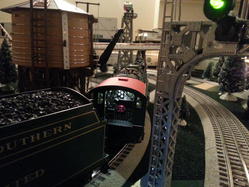I noticed that the "tender" is used, in many cases as the point of origin to refill and store water for your steam locomotive. To simulate this in O-Gauge railroading, it would seem that one would think that the locomotive would house the water. After all, how would you get the water from the tender to the locomotive? However, how much water could it really store. Doesn't the tender house the coal? What I have read up to this point, that the tender houses the water and the coal. See my pic. Can someone fill me in on the logic of which would be the most realistic? The Engine or the Tender? Thanks in advance.






